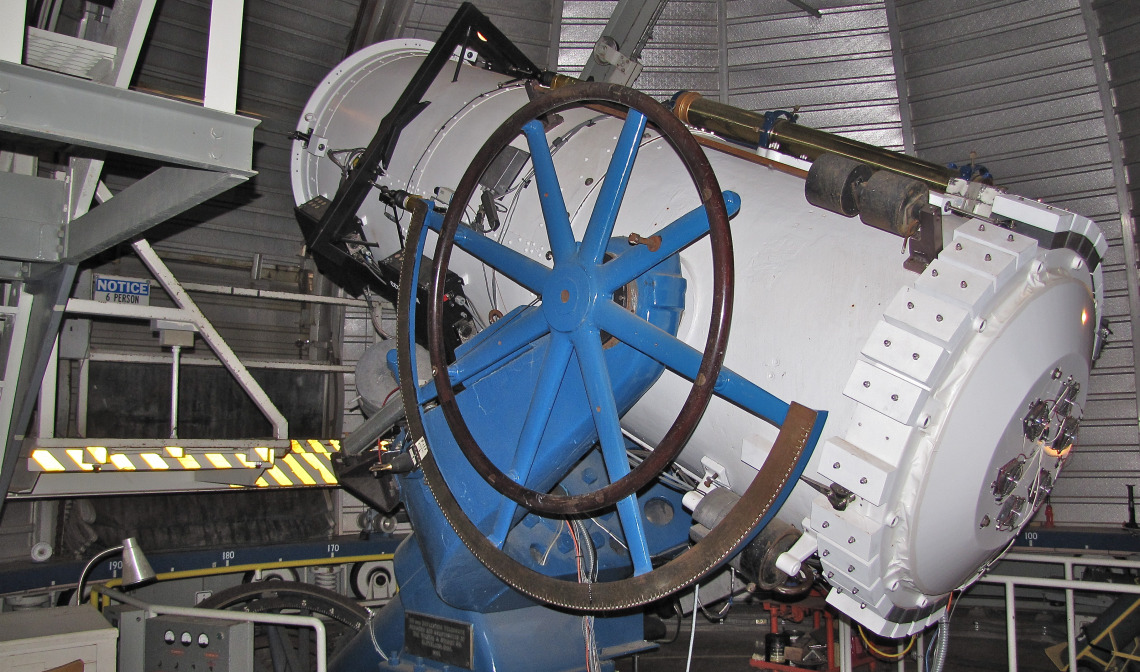
0.9-meter SPACEWATCH® telescope viewed from the NE
Credit: Roger E. Carpenter, MD
SPACEWATCH® is the name of a group at the University of Arizona's Lunar and Planetary Laboratory founded by Prof. Tom Gehrels and Dr. Robert S. McMillan in 1980. Today, SPACEWATCH® is led by Dr. Melissa J. Brucker.
The original goal of SPACEWATCH® was to explore the various populations of small objects in the solar system, and study the statistics of asteroids and comets in order to investigate the dynamical evolution of the solar system.
Studies included the Main-Belt, Centaur, Trojan, Comet, Trans-Neptunian, and Earth-approaching asteroid populations. SPACEWATCH® also found potential targets for interplanetary spacecraft missions. Since 1998, SPACEWATCH® has focused primarily on follow-up astrometry of such targets, and especially monitors the positions and motions of objects that might present a hazard to the Earth.
CCD observations are conducted 24 nights each lunation with the Steward Observatory 0.9-meter SPACEWATCH® telescope and the SPACEWATCH® 1.8-m telescope, both on Kitt Peak. Emphasis today is on recovering faint solar system objects, especially Near Earth Asteroids which have been found to pose an impact hazard, such as the Virtual Impactors (VI's) and Potentially Hazardous Asteroids (PHA's). Other objects of interest include targets of Radar, possible destinations for human exploration and objects discovered by the WISE and NEOWISE surveys which have valuable infrared estimates of their size. The 1.8-meter telescope allows us to observe objects up to 0.7 magnitudes fainter than the 0.9-meter telescope. To complement the deep penetration of the 1.8-m, we have put a mosaic of CCDs on the 0.9-m telescope. This permits us to cover sky faster than the pre-2002 system.
Following the motion of asteroids soon after discovery, and recovering them on return apparitions are essential to prevent priority objects from becoming lost. SPACEWATCH® averages 1300 NEOs, including 160 Potentially Hazardous Asteroids (PHAs) observed per year. Per year we make about 140 observations of PHAs with apparent V magnitudes equal to or fainter than 22.5, making SPACEWATCH® the most productive station in the world in that category.
Upgrades in hardware, software, and observing procedures since 2015 Sept have boosted the numbers of observations of NEOs we make with the 0.9-m, 1.8-m, and 2.3-m telescopes on Kitt Peak in Arizona. Targeting specific NEOs with our 0.9-m telescope (IAU site code 691) down to V magnitude 22 has increased the rate of observations of NEOs with that telescope by a factor of 4.6 compared to its previous survey pattern. Compared to 2011-2015, in 2016 our 1.8-m telescope (IAU site code 291) showed a 43 per cent increase in the number of PHAs observed. Installation of our new CCD camera at the Cassegrain focus of the Bok 2.3-meter telescope of Steward Observatory (IAU site code 695) in 2015 and better software have allowed 2.9 times more targeted objects per night with that telescope down to R magnitude 23.
Notable discoveries, milestones, and PowerPoint presentations are in the News section.
Some of SPACEWATCH®'s distinctions:
- First to use CCD-scanning routinely in astronomy.
- First to use CCDs to survey the sky for comets and asteroids.
- First near-Earth asteroid discovered with a CCD (1989 UP).
- First astronomical group to develop automated, real-time software for moving-object detection.
- First to discover a near-Earth asteroid by software (1990 SS). See the images and information page for 20th anniversary of this discovery.
- First to use a CCD to discover a comet, which was also the then-faintest comet at the time of discovery (125P/1991 R2).
- First automatic discovery of a comet (C/1992 J1).
- Discovered the C or S type asteroid with closest approach to the Sun at time of discovery (1995 CR at 0.120 AU).
- Identified two new asteroid populations - small NEAs and distant Centaurs.
- Discovered fastest rotating and most accessible asteroid at time of discovery (1998 KY26).

